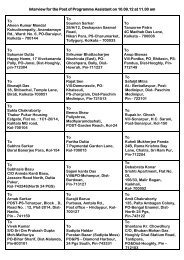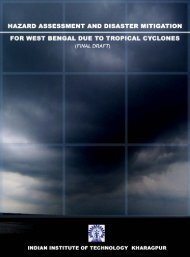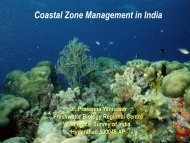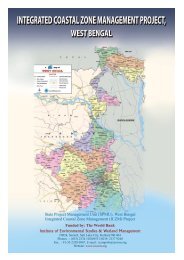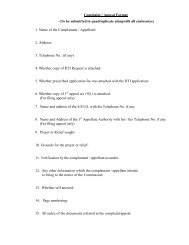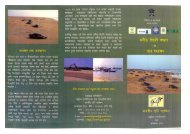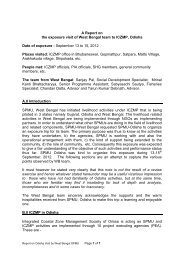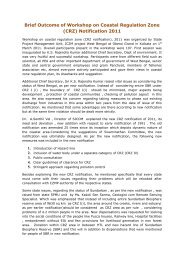INDIA: Integrated Coastal Zone Management Project
INDIA: Integrated Coastal Zone Management Project
INDIA: Integrated Coastal Zone Management Project
Create successful ePaper yourself
Turn your PDF publications into a flip-book with our unique Google optimized e-Paper software.
<strong>INDIA</strong> <strong>Integrated</strong> <strong>Coastal</strong> <strong>Zone</strong> <strong>Management</strong> <strong>Project</strong> (P007985)<br />
First Implementation Support Mission, June 2011<br />
workers are primarily responsible for mobilization of the community and collection of household data,<br />
where as qualitative data through PRA exercise is collected by the project coordinators. The field workers<br />
are stationed in the villages and each of them covers 5 to 7 villages. All the three project coordinators are<br />
women and over one third of the field workers are also women. All project coordinators and almost all<br />
field workers have experience of working either in government projects / schemes or NGO sector.<br />
5. Visit to Khijadiya village: The mission visited Khijadiya village situated close to Khijadiya bird<br />
sanctuary. The mission was pleased to note that field coordinators are emphasizing the value of literacy<br />
and have taught women to write their names, built confidence that women can approach banks (mobile<br />
banks visits the village) and operate bank accounts. Books of account are being maintained meticulously<br />
in each village and discussions are also properly recorded as minutes of the meeting. The women in<br />
Khijadiya village have developed unique embroidery skill called "machi work" or "karchok" and SHGs<br />
wants upward market linkages to strengthen their acumen and gain livelihood through promotion of their<br />
craft. The community also showed keen interest in developing eco-tourist model village, given their<br />
proximity to the bird sanctuary. In order to sustain, SHGs need to go beyond one single trade. The EDC<br />
has taken up the village sewerage system along the cement concrete village road. So far EDC has<br />
completed construction of 300 meters of cement concrete road and 780 meters of sewerage system.<br />
Individual beneficiaries include 20 landless families those who received 70 solar cookers; 2 bio gas plants<br />
to two families; and 40 women members received training in sewing and embroidery.<br />
6. Visit to Mota Asota village: The mission also visited Mota Asota village situated in the vicinity of Marine<br />
National Park. As per the PRA findings, 1100 meters of connecting road from Mota Asota village to<br />
Gadu Island was identified as entry point activity. However, villagers contributed to extend that road to<br />
3300 meters to connect Azad Island to the main land thereby reducing the distance, travel time and also<br />
saving on fuel. The EDC in this village assisted forest department in planting mangroves in about 90 ha<br />
of land. Five SHGs have been formed in this village. The community expressed its satisfaction on the<br />
entry point activity taken up by SPMU and also on mangrove plantation as this provided employment<br />
opportunities to the vulnerable community of the village.<br />
7. Visit to the site of Jamnagar Sewerage Treatment Plant: The mission also visited the site for the proposed<br />
70 million litre per day sewerage treatment plant. Around 60 acres of land was acquired in 1988. Though<br />
all 25 land owners have been paid compensation, a few of them (who have neighboring land holding)<br />
continued to cultivate the land. Discussions suggested that these neighboring land-owners have no<br />
objections if the land is now not available for their use. The mission was informed that temple located in<br />
the acquired land will not be relocated. The project will also provide access road to the temple.<br />
8. Way Forward: Additional attention will be given to the issues related to (a) sustainability of SHGs<br />
through market linkages; identification and implementation of well defined and demand driven trades.<br />
SHGs need to be linked to the government run schemes; and (b) priority implementation of identified<br />
entry point activities to sustain the momentum generated among the communities.<br />
Odisha<br />
9. Staffing: SPMU has appointed a Rural Development Expert who works across the components. However,<br />
there is no support at the field level for the SPMU staff. It was agreed that SPMU will be strengthened by<br />
August 31, 2011. Instead of hiring NGOs to carry out social assessment for project villages, SPMU will<br />
hire 20 Community Organizers for 127 villages. Each organizer will cover 10 to 12 villages. To provide<br />
guidance to the community organizers, SPMU will also hire 7 Field Coordinators who will report to 4<br />
project coordinators. The community organizer at the village level will be responsible for mobilization of<br />
the community and as well as for collection of household data. The qualitative data through PRA exercise<br />
will be collected by the project coordinators with the help of field coordinators. The field coordinators<br />
will also be responsible for quality control of household data and briefing of community organizers for<br />
quantitative data collection process. SPMU shared the draft household questionnaire with the mission. It<br />
61






